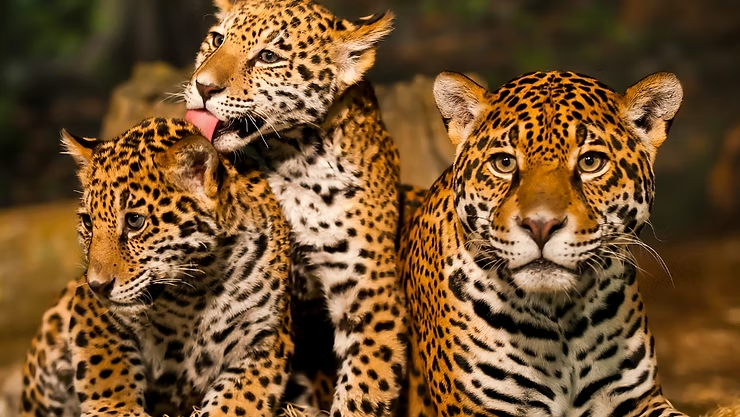Top 10 Facts About Jaguars
Jaguars are fascinating big cats known for their powerful build, stealthy hunting techniques, and striking rosetted coats. Found across Central and South America, they inhabit diverse habitats from rainforests to wetlands. Solitary yet highly adaptable, jaguars play a vital role as apex predators in maintaining ecosystem balance.
Key Takeaways
- Jaguars have beautiful spotted coats and muscular bodies.
- They inhabit rainforests, swamps, grasslands, and scrublands.
- They are carnivorous apex predators with varied prey.
- Jaguars are solitary and highly stealthy hunters.
- Females can reproduce throughout the year.
Physical Characteristics
Jaguars are stocky and muscular with large heads, strong jaws, short legs, and long tails for balance. Their coat is tan or orange with distinctive black rosettes, aiding camouflage. Retractable claws allow them to climb trees and capture prey efficiently.
Habitat
Jaguars thrive in diverse habitats, including rainforests, swamps, grasslands, and scrublands. They are often near water, showcasing strong swimming abilities. Their range extends from southern United States historically to Argentina today, with the Amazon rainforest and Pantanal wetlands hosting the largest populations.
Diet
Jaguars are carnivores, feeding on large prey such as deer, tapirs, peccaries, and caimans. They also hunt smaller animals like monkeys, birds, and fish. With the strongest bite force of any big cat, they often kill by targeting the skull or neck. They are skilled swimmers, hunting aquatic prey when necessary.
Behavior
Jaguars are solitary and territorial, marking their areas with scent and claw marks. Ambush hunting is their primary strategy, utilizing stealth and patience. They can climb trees and drag prey into branches for safekeeping, and are capable of swimming long distances for hunting or movement.
Reproduction
Jaguars mate primarily during the rainy season. Females have a gestation period of 90–110 days, giving birth to 1–4 cubs. Cubs are blind at birth and rely entirely on the mother for food, protection, and hunting skills. They stay with their mother for about two years before becoming independent.
Jaguar vs Leopard
Jaguars are robust with larger heads and more muscular builds than leopards. Their rosette patterns are distinctive, and their bite force is stronger, often used to crush skulls. Leopards are generally smaller, more slender, and rely on different hunting strategies.
Hunting Techniques
Jaguars rely on camouflage, patience, and ambush techniques. They can hunt large prey, including caimans, and aquatic species like fish. Their unique strategy often involves crushing the skull with powerful jaws. Their swimming ability provides an advantage over other big cats in aquatic environments.
Geographical Distribution
Jaguars are native to Central and South America, spanning Mexico to Argentina. Concentrations are highest in the Amazon rainforest and Pantanal wetlands. Countries with jaguar populations include Belize, Costa Rica, Guatemala, Honduras, Nicaragua, Panama, Colombia, Ecuador, Guyana, Suriname, Venezuela, Bolivia, Paraguay, and Peru. Jaguars are now extinct in the U.S.
Conservation
Jaguars face habitat loss, poaching, human-wildlife conflict, and climate change threats. Conservation efforts include:
- Habitat preservation through national parks and reserves.
- Anti-poaching laws and monitoring programs.
- Community engagement via education and sustainable livelihoods.
- Research and population monitoring using camera traps and satellite tracking.
- International collaboration on conservation strategies.
Success stories include protected areas, anti-poaching enforcement, and human-jaguar coexistence programs, showing collective efforts can ensure jaguar survival.
Jaguar Mythology and Cultural Significance
Jaguars are revered in indigenous cultures as symbols of power, protection, and courage. In Mayan mythology, they represent the underworld and rain god, while Brazilian folklore portrays jaguars as shapeshifters. Jaguars are depicted in art, symbolizing royalty, divinity, and strength across pre-Columbian and contemporary works.
Jaguar in Popular Culture
Jaguars appear in films and media:
- The Jungle Book (2016) – Bagheera is inspired by jaguars.
- Rio (2011) – Features a jaguar antagonist named Nigel.
- The Pink Panther (1963) – Jaguar symbol used for the diamond.
They continue to inspire art, stories, and cultural symbolism, representing strength and agility.
Frequently Asked Questions
- Average lifespan? 12–15 years in the wild; up to 20 in captivity.
- Top speed? Up to 50 mph (80 km/h).
- Endangered? Near-threatened; populations declining due to habitat loss and hunting.
- Largest recorded jaguar? 350 pounds (160 kg), 7 feet (2.1 m) long.
- Swim ability? Excellent swimmers; hunt in rivers and lakes.
- Solitary? Yes, they prefer to live and hunt alone.
- Climb trees? Yes, for rest, escape, or ambush.
- Roar? Yes, deep powerful roar used for communication and territory marking.

